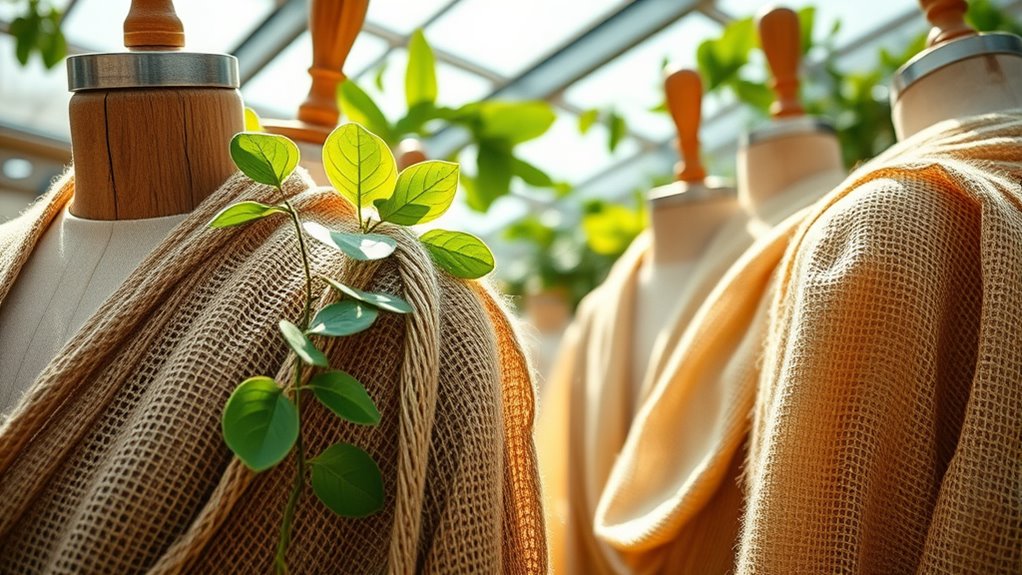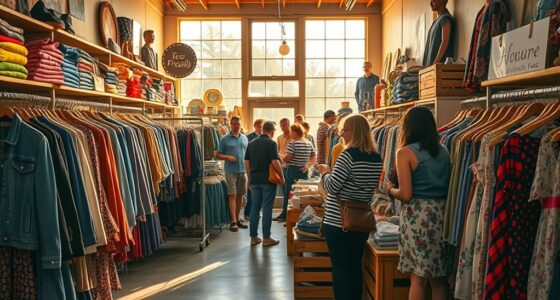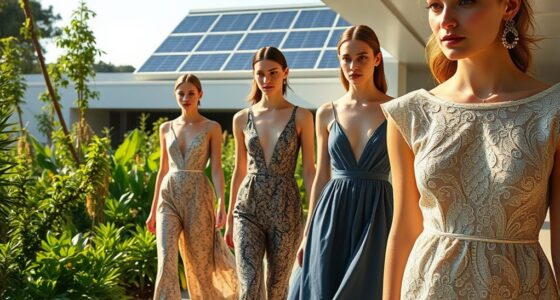Discover five innovative sustainable fabrics that could revolutionize fashion: Tencel, made from wood pulp; organic cotton, grown without harmful chemicals; hemp, which requires minimal water; Piñatex, made from pineapple leaf fibers; and recycled polyester, created from post-consumer plastics. These fabrics support eco-friendly dyes and circular fashion principles, reducing water pollution and waste. By choosing these materials, you can help promote a more responsible industry. Keep exploring to learn how embracing these fabrics can truly change fashion forever.
Key Takeaways
- Organic cotton minimizes pesticide use, reduces water consumption, and supports eco-friendly farming practices.
- Tencel (Lyocell) is produced from sustainably sourced eucalyptus wood using closed-loop processes that recycle solvents.
- Piñatex uses pineapple leaf fibers, transforming agricultural waste into durable, eco-friendly textile material.
- Hemp fabric grows quickly with minimal water and chemical inputs, making it a sustainable and versatile textile option.
- Recycled fabrics, such as polyester derived from plastic bottles, help reduce waste and lower the environmental impact of fashion.

Have you ever wondered how your clothing choices impact the environment? Every time you buy a new shirt or pair of jeans, there’s more at stake than just your style—you’re part of a larger system that affects ecosystems, water supplies, and carbon emissions. But there’s good news: sustainable fabrics are transforming fashion, making it more eco-friendly and innovative. One key aspect is the use of eco friendly dyes, which minimize the harmful chemicals traditionally used in fabric coloring. Conventional dyes often pollute water sources and harm wildlife, but eco friendly dyes use plant-based, natural, or low-impact chemicals that reduce environmental damage. When you choose garments colored with these dyes, you’re helping cut down water pollution and supporting manufacturers committed to sustainability.
Choosing eco friendly dyes reduces water pollution and supports sustainable fashion practices.
Another vital concept gaining momentum in sustainable fashion is circular fashion. This approach shifts away from the traditional linear model—where clothes are produced, worn, and discarded—to a closed-loop system. With circular fashion, items are designed to be reused, recycled, or upcycled, extending their life cycle and reducing waste. If you participate in circular fashion, you’re actively contributing to a system where textiles are valued beyond their initial use. You might buy from brands that take back old clothes for recycling or choose pieces made from fabrics that can be easily repurposed. Circular fashion encourages you to think differently about your wardrobe, prioritizing quality, durability, and the potential for reuse rather than fast consumption.
These innovations aren’t just trendy; they’re practical ways for you to make a real difference. Switching to garments made with eco friendly dyes means supporting brands that invest in cleaner production methods, which ultimately reduces your carbon footprint. Embracing circular fashion means you become part of a movement that minimizes textile waste and conserves resources. It’s about shifting your mindset from disposable fashion to a more thoughtful, sustainable approach where your clothing choices have a positive impact. Many brands are now adopting these practices, making it easier for you to shop consciously without sacrificing style or quality.
Ultimately, sustainable fabrics and practices like eco friendly dyes and circular fashion are redefining what it means to be fashionable. Your choices can promote a more sustainable industry and help protect the planet. By opting for eco-conscious options, you’re not only expressing your personal style but also advocating for a future where fashion is kinder to the environment. It’s a powerful step toward change, reminding you that even small decisions—like choosing sustainable fabrics—can lead to a bigger impact. As more people embrace these innovations, the fashion industry will continue to evolve, becoming more responsible and environmentally friendly for generations to come.
Frequently Asked Questions
Are Sustainable Fabrics as Durable as Traditional Textiles?
You might wonder if sustainable fabrics are as durable as traditional textiles. Generally, they can be, but biodegradability concerns sometimes influence longevity. Opting for fabrics made through ethical sourcing practices guarantees quality and durability. While some sustainable materials may wear faster, advancements are improving their quality. By choosing ethically sourced, durable sustainable fabrics, you support eco-friendly fashion that’s both long-lasting and better for the planet.
How Do Sustainable Fabrics Impact Clothing Affordability?
Imagine a brand switching to organic cotton, which initially costs more. You might see a higher price tag, but over time, lower production costs and increased demand can reduce costs. Sustainable fabrics often have greater cost variation, impacting consumer accessibility. While some eco-friendly textiles may be pricier upfront, the long-term benefits, like durability and reduced environmental impact, can make sustainable fashion more affordable for everyone.
Can Sustainable Fabrics Be Recycled or Repurposed Easily?
You might wonder if sustainable fabrics are easy to recycle or repurpose. While they often have a longer fabric lifespan, recycling challenges can arise due to complex fiber blends or treatments. These factors make repurposing more difficult, limiting the ease of recycling sustainable fabrics. However, innovations are improving recycling methods, and choosing fabrics designed for easier recycling can help you contribute to more sustainable fashion practices.
What Are the Environmental Benefits of Sustainable Fabrics?
You’ll find that eco-friendly certifications guarantee sustainable fabrics meet strict environmental standards, making them a smart choice. By choosing these fabrics, you help reduce the carbon footprint associated with production. They often use less water, energy, and chemicals, which benefits the planet. When you opt for sustainable fabrics, you actively support a healthier environment, promote responsible manufacturing, and contribute to a more sustainable fashion industry.
Are Sustainable Fabrics Suitable for All Types of Clothing?
You may wonder if sustainable fabrics suit all clothing types. Fiber innovations are making sustainable options more versatile, but consumer acceptance varies depending on the fabric’s look and feel. While some sustainable fabrics work well for casual or activewear, others may not yet match the durability or texture needed for formal wear. So, consider the fabric’s properties and consumer preferences to determine if it’s suitable for your desired clothing.
Conclusion
By choosing sustainable fabrics, you’re planting seeds for a greener future in fashion. Imagine your wardrobe as a vibrant garden, where each eco-friendly fiber blooms with purpose and promise. Every fiber you wear becomes a ripple in the pond of change, transforming the tides of industry toward harmony with nature. So, embrace these fabrics and become a catalyst—turn your style into a powerful force that can rewrite the story of fashion, one eco-friendly thread at a time.









